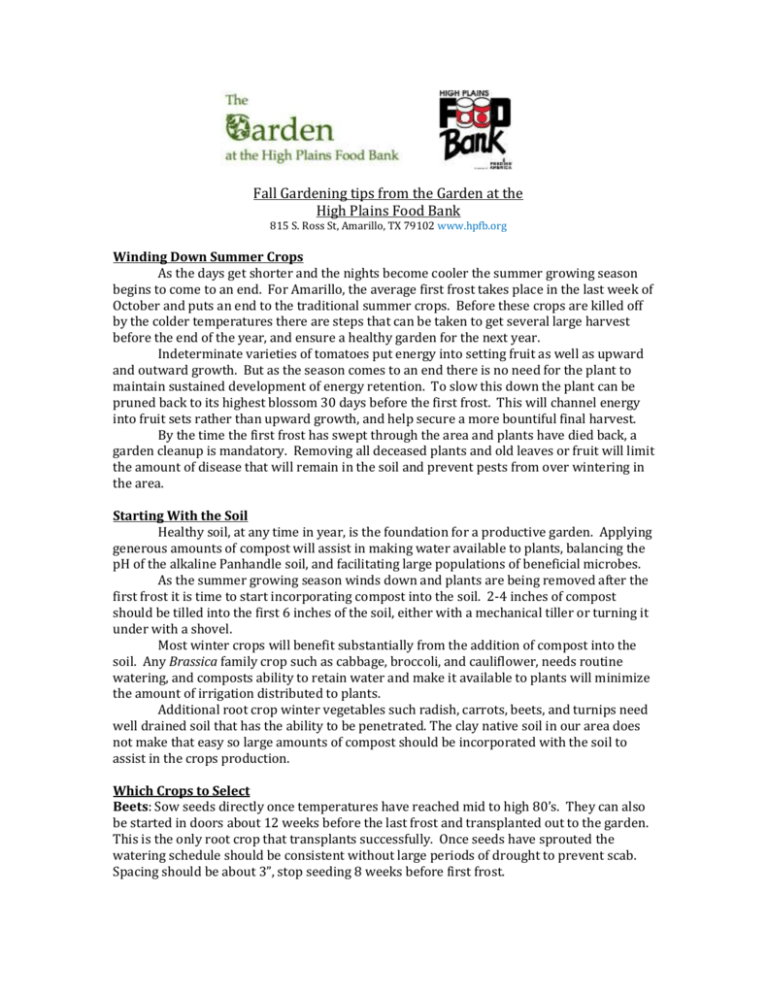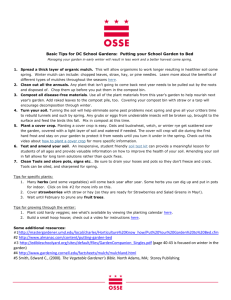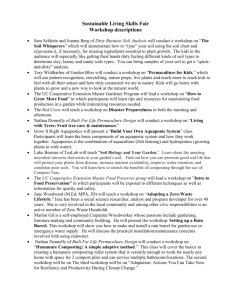Fall Gardening tips from the Garden at the High Plains Food Bank
advertisement

Fall Gardening tips from the Garden at the High Plains Food Bank 815 S. Ross St, Amarillo, TX 79102 www.hpfb.org Winding Down Summer Crops As the days get shorter and the nights become cooler the summer growing season begins to come to an end. For Amarillo, the average first frost takes place in the last week of October and puts an end to the traditional summer crops. Before these crops are killed off by the colder temperatures there are steps that can be taken to get several large harvest before the end of the year, and ensure a healthy garden for the next year. Indeterminate varieties of tomatoes put energy into setting fruit as well as upward and outward growth. But as the season comes to an end there is no need for the plant to maintain sustained development of energy retention. To slow this down the plant can be pruned back to its highest blossom 30 days before the first frost. This will channel energy into fruit sets rather than upward growth, and help secure a more bountiful final harvest. By the time the first frost has swept through the area and plants have died back, a garden cleanup is mandatory. Removing all deceased plants and old leaves or fruit will limit the amount of disease that will remain in the soil and prevent pests from over wintering in the area. Starting With the Soil Healthy soil, at any time in year, is the foundation for a productive garden. Applying generous amounts of compost will assist in making water available to plants, balancing the pH of the alkaline Panhandle soil, and facilitating large populations of beneficial microbes. As the summer growing season winds down and plants are being removed after the first frost it is time to start incorporating compost into the soil. 2-4 inches of compost should be tilled into the first 6 inches of the soil, either with a mechanical tiller or turning it under with a shovel. Most winter crops will benefit substantially from the addition of compost into the soil. Any Brassica family crop such as cabbage, broccoli, and cauliflower, needs routine watering, and composts ability to retain water and make it available to plants will minimize the amount of irrigation distributed to plants. Additional root crop winter vegetables such radish, carrots, beets, and turnips need well drained soil that has the ability to be penetrated. The clay native soil in our area does not make that easy so large amounts of compost should be incorporated with the soil to assist in the crops production. Which Crops to Select Beets: Sow seeds directly once temperatures have reached mid to high 80’s. They can also be started in doors about 12 weeks before the last frost and transplanted out to the garden. This is the only root crop that transplants successfully. Once seeds have sprouted the watering schedule should be consistent without large periods of drought to prevent scab. Spacing should be about 3”, stop seeding 8 weeks before first frost. Broccoli: A great crop that can be started indoors in the summer and then transplanted in mid-September. Broccoli does not handle the heat too well so it is best gauge the transplanting time by days where the temperature is routinely below 90 degrees F. Space plants 8” apart, in rows separated by 18” Carrots: This crop can struggle in the compacted soil of the High Plains. Amending soil with sand, peat, or compost will ensure proper drainage and enough space to get established. Sow seeds about 1” apart. Sow every 3 weeks to ensure a steady supply through the season. Cauliflower: Can be sown indoors around June and placed out in the garden early September. This crop needs lots of water and is a heavy feeder of nutrients in the soil. Can be high maintenance because of the need of blanching to ensure a quality harvest. Plant 18” spacing. Kale: Can be either sown inside and planted 2 months after seeding date, or directly sown 3 months before the first frost. Sow seeds directly every 2.5”. This is a fantastic fall crop that can withstand some of the seasons coldest temperatures and flavor stays intact. Kohlrabi: An unusual looking root vegetable, kohlrabi is one of the better cold tolerant crops. Its flavor is similar to turnips and its leaves can be eater like kale or cabbage. Sow seeds 1” apart and than thin to 4” once sprouts emerge. Lettuce: A crop best grown in temperatures 60-65 degrees F. Plant 10 seeds 1” in rows 12”-18” apart every week to provide enough for a continuous supply Radishes: A prolific crop for the Amarillo area, radishes grow easily and quickly. Sow seeds directly 1” apart. There are several varieties that can give variations in color and flavor Swiss Chard: A great tasting and great looking leafy crop. Chard grows easily from seed and can grown from mid summer and into the cooler temperatures of fall. Space 4”-6” in rows separated by 12”-18”. Turnips: Another easily grown root vegetable that is nutrient rich. Sow seeds directly 1” apart in rows separated by 12”-18”. Other Jobs for the Fall As fewer growing options are available due to colder weather, there is still plenty that can be done in the garden. Plant remains can be collected and incorporated in a compost pile. Creating ample amounts of compost in the colder months will prevent a shortage when it is needed most in the spring. By adding several layers of brown material (dead, dry material like wood chips, dead plant waste), and green material (food scraps, grass clippings) while spraying the pile down with a hose to obtain the moisture of a rung out sponge. Compost, or manure should be added after the spring and fall crops have been removed. This will allow for nutrients to be restored to the soil and give them plenty of time to be incorporated by the next growing season. This time can also be used to look through seed catalogs to determine which new crops and varieties are worth trying for the next year. Planning plant locations and space needed will help with determining how many plants and seeds you will need to purchase and how you can begin to prepare for next spring. Additionally, this time can be used to addresss large projects in the garden. Is there a gazebo, arbor, or shade structure you would like to construct in the garden? Now is the time to do it when there is less demand from plants. This will help with getting a vision for what plants can be incorporated around your new space and also get you excited for the growing season to come.





